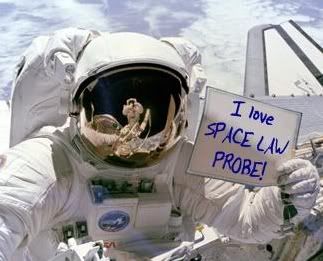11.09.2007
Unfunded mandate vs. "cosmic extinction"
 On the Hill yesterday it wasn't quite duck and cover during the anticipated hearing on NASA's March 2007 report to Congress on near-Earth objects (NEOs), but as Loretta Hidalgo Whitesides reports, lawmakers "chided NASA yesterday for ignoring the risk of a large rock slamming into earth" and a mandate from Congress.
On the Hill yesterday it wasn't quite duck and cover during the anticipated hearing on NASA's March 2007 report to Congress on near-Earth objects (NEOs), but as Loretta Hidalgo Whitesides reports, lawmakers "chided NASA yesterday for ignoring the risk of a large rock slamming into earth" and a mandate from Congress.For NASA's part, Scott Pace told House Science Committee’s space subcommittee, "NASA would be pleased to implement a more aggressive NEO program, if so directed by the President and Congress. However, given the constrained resources and strategic objectives the Agency has already been tasked with, NASA cannot place a new NEO program above current scientific and exploration missions."
Astronaut and champion NEO-buster Rusty Schweickart of the B612 Foundation, who has critiqued NASA's NEO report, testified before the subcommittee about various aspects of NASA's report to Congress (which the agency prepared in response to the NASA Authorization Act of 2005 (P.L. 109-155)), including NEO tracking, search, discovery, deflection, the Spaceguard Survey, size matters (yes it does) and more. Here is his prepared statement.
Rusty criticised the space agency for failing to recommend a program to meet the 140-meter search goal, but said: "One can sympathize with NASA's fear of the dreaded 'unfunded mandate' from Congress while decrying the Agency's decision to defy the Congressional directive and to delay the initiation of this critical search program."
He wants NASA to produce a supplement to its NEO report "based on new knowledge which has come to light since it began its analysis."
Apart from technical, budgetary and other issues arising from the threat of potentially Earth-shattering NEOs, on the legal side, Rusty said "the single most important question" of the hearing was: "What governance structures should be established to address potential NEO threats?" Good question. He said NEO work at NASA "in an orphaned status" and recommended that Congress make NASA responsible for the "technical development elements of protecting the Earth from NEO impacts as a public safety responsibility."
And beyond technical responsibility? Rusty concluded with the obvious obsevation, that NEO mitigation "is a planetary challenge, not a national one."
But no worries. There's an infinite amount of time to figure this all out and decide what to do next. Or is there.
Meanwhile, thank goodness it's Friday, but not Friday, April 13, 2029, when NEO-trackers say there is a one in 45,000 chance that the small (250-meter) asteroid Apophis could swing by for a little close-up of Earth (and possibly return in 2030).
An yes, we're looking forward to results of the Planetary Society's $50,000 competition to design a mission to rendezvous with a near-Earth asteroid such as Apophis.
(By the way, if you find yourself in NYC, now would be a good time to rocket over to the Hayden Planetarium for the spectacular space show, Cosmic Collisions. And if Rusty is in town I'll be happy to treat him to it.)
* * *
IMAGE: © American Museum of Natural History, "A young Earth is pictured moments after a collision with a Mars-sized wandering planetoid over four billion years ago."
----------------------------------------------------------
We have the ability to make ourselves safe from cosmic extinction.
--R. Schweickart






